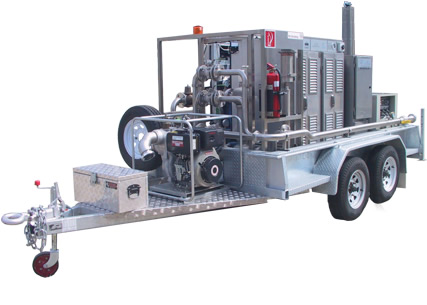Ozone Generators
Pipeline Disinfection System (PDS)
Under the Water Supply Code of Australia and to protect public health, water authorities are required to disinfect new water mains where practicable before they are put into service. Existing mains that have been repaired or refurbished are normally only flushed to remove potential contaminants before re-entering service.
In Sydney the responsibility to deliver portable water to residents that is clean and free of harmful bacteria falls to the Sydney Water Corporation. Sydney Water is responsible for ensuring that new mains, repairs or maintenance within their systems are undertaken according to agreed processes minimising the risk to public health.
Superchlorination was typically used to disinfect pipes and tanks for the distribution and storage of portable water. There is a significant downside to its use in that it can be time consuming, harmful to people and toxic to the environment.

After a new pipeline is laid and before it is put into service, it is usually cleaned and disinfected. Chlorine disinfection entails first flushing, to remove potential debris and then filling the new section with superchlorinated water to inactivate harmful bacteria. The Superchlorination process can take up to 24 hours to be effective dependant on the concentration used. This may cause delays when treating new mains and can also present a significant logistical problem when trying to return repaired mains back into service. Due to the time taken to disinfect mains using chlorine most repaired mains are returned to service after flushing only.
Less time is required to disinfect with ozone; it is more effective and cheaper to use than chlorine; the process is safer for the operators and it is safe for the environment.
The first ozone Pipeline Disinfection System (PDS) has now been operating for 2 years and a further 2 units were delivered to Sydney Water in March 2014. The trailers to date have proven to be reliable with no failures in service and have achieved their intended purpose.
For a customer of the utility, the use of the ozone process is cost effective and reliable in achieving disinfection. When using the Superchlorination process there may be a potential risk of customers accidently receiving highly chlorinated water. The ozone process eliminates this risk. If ozonated water were to be accidently released to customers the risk would be negligible as ozone decays very quickly.
Ozone treatment has been shown to deliver a very high success rate from biological testing against that of chlorine. This predictability allows the water utility to plan the use of its crews with a greater level of certainty that work will be completed on time. Costing by Sydney Water has shown that under their operating and testing conditions the ozone system has a direct saving of over 40% on each job with vastly improved connection times. The ozone process has shown a very high return on investment in a very short period of time.
For the operator, the PDS provides a safer working environment without chemical burns to skin or clothing. It has automatic leak sensing and shutdown procedures in place to ensure ozone gas concentrations around the unit remain well below safe working levels. Operation of the PDS is straightforward and consistent.
100% Australian Made and Manufactured
Oxyzone products are designed and manufactured in Australia to comply with electrical and safety standards. Our Service personnel and spare parts are also in Australia.
